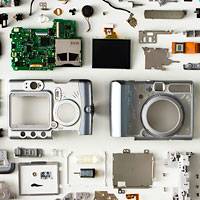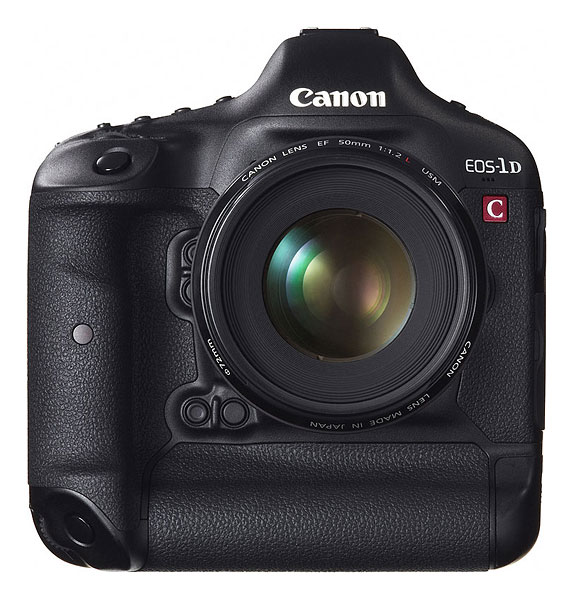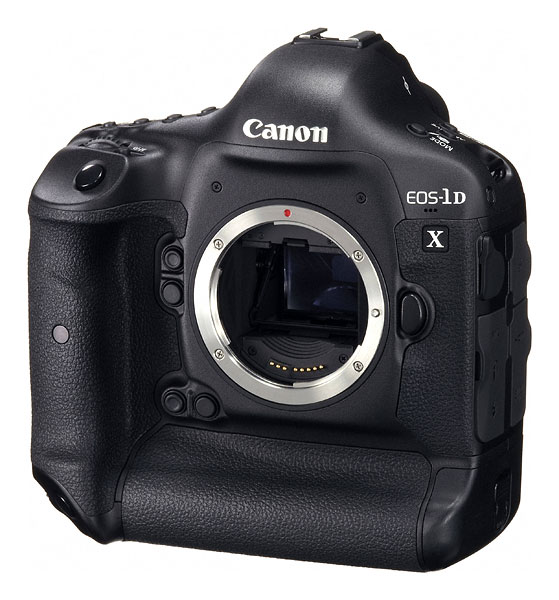Firmware Friday: New features for Canon EOS-1D X, 1D C; Fuji X100 interchangeable-lens cameras
posted Friday, October 25, 2013 at 2:39 PM EST

Things have been rather quiet on the firmware front of late, but after a brief hiatus, Firmware Friday makes its return with several announcements from Canon and Fujifilm.
We'll start with Fujifilm, whose new firmware is already available for download. (Canon's firmware has been announced, but not yet shipped.)
The Fuji FinePix X100 and X100 Black cameras have both been updated to version 2.00, and the new firmware makes some pretty significant improvements. It mirrors changes made to the X-Pro1, X-E1, and X100s earlier this year, improving performance and adding focus peaking, among other changes.

In full, Fuji lists changes made in the new X100 v2.00 firmware as follows:
-
Improvement of AF speed
Approximately 20% faster AF speed is achieved in various conditions such as bright scenes, dark scenes and changed focus distance compared to the previous firmware version. -
Improvement of close-up focus performance
The focus distance from the lens surface without switching to macro mode is approximately 30% shorter compared to previous firmware version. -
"Focus Peak Highlight" function for manual focusing is added.
The function, which features on FUJIFILM X100S and X20, is added and assists accurate and sensitive manual focusing by enhancing the outline of your subject in high contrast.
* With this update, "Focus Peak Highlight" function is selected as a default setting. Pressing the center of the command dial for a while enables you to switch the setting of "Focus Peak Highlight" and "STANDARD" (off of "Focus Peak Highlight"). And "MF ASSIST" is added in SHOOTING MENU where you can select "HIGH" and "LOW" in "Focus Peak Highlight" and "STANDARD". -
Improved manual focus operation
This makes it easier to capture the peak of the focus by displaying the image with shallow depth of field, using open aperture, when adjusting the focus with the electronic view finder or the LCD. -
Faster start-up time
The camera start-up time is shortened by approximately 0.2 second with QUICK START mode OFF. -
Improved operability of selecting focus area
Previously, the focus area was selected while holding the AF button on the back. With the upgraded firmware, pressing the AF button will switch to the focus area selection screen and the area of your choice can then be selected. -
The phenomenon is fixed that a camera will automatically turn off during "Bulb (B)" shooting with the "CONTINUOUS" setting in "IMAGE DISP."
If you own the Fuji X100 or X100 Black and want to get the update -- or just more information on what it entails -- you'll find this on Fuji's website.

Canon, meanwhile, has announced two updates for its digital SLRs, but they're not yet available. The Canon EOS-1D C will be first to get its update, which lands next month, while an update for the EOS-1D X will follow in January 2014.
The EOS-1D C's update is more straightforward, with just two changes according to Canon, perhaps explaining why it arrives so much sooner:
-
EF Lens Communication
The new service update for the EOS-1D C Digital SLR Cinema camera will enable Canon EF-mount Cinema lenses to store lens metadata in the video recorded by the camera. Furthermore, Canon EF-mount Cinema lenses will be supported by Peripheral Illumination and Chromatic Aberration Correction functions, helping to improve overall image quality. -
Audio Recording
In response to user requests, audio on the EOS-1D C camera has also been enhanced. Currently audio recording is limited to a MIC input, but the forthcoming service update will permit selection of LINE or MIC input, allowing use of a wider variety of external audio sources.

The wait for the Canon EOS-1D X firmware, though, should be well worthwhile. There are no less than ten operational improvements that will be made, according to Canon:
-
AF Performance with Moving Subjects
For greater creative control, additional parameters have been added to AI Servo 2nd Image Priority, enabling users to adjust these settings for more accurate AF performance according to the situation at hand. Photographers can fine-tune the balance between prioritizing focus versus the framing rate for the second and subsequent shots in a burst. -
Enhanced AI Servo AF Performance in Low Light Conditions
The AI Servo focusing algorithm has been improved to allow more time for light sampling during AF activation prior to shutter release, enhancing AF performance in low-light situations. Additionally, initial AF control is now based on the new "+2 focus priority" setting of AI Servo 2nd Image Priority, which has higher distance measurement capabilities under low-light conditions. Upon full depression of the shutter button, settings from AI Servo 1st Image Priority take over and then settings from AI Servo 2nd Image Priority are applied on any subsequent images in the burst. This increases the probability that the first image in a burst sequence will be as sharp as possible. -
Improved Acceleration/Deceleration Tracking Parameters
To improve tracking performance of fast-moving subjects that fill the frame, additional parameters for acceleration/deceleration tracking in AI Servo AF have been added to provide photographers with more precise control when photographing rapidly moving subjects that accelerate or decelerate quickly or unexpectedly. In response to feedback from professional photographers, these new settings have been added to handle larger differences in speed (i.e., the rate of change in image magnification) compared to the previous firmware. -
Selection of Initial AF Point While Shooting in 61-Point Auto Selection AF
This new option in the AF Menu provides more continuity when switching to 61-Point Auto Selection AF from any other AF Point Selection mode. The option maintains the AF point selected from the previous Selection mode as a starting point for 61-Point Auto Selection AF. It also maintains the ability to change to a pre-programmed AF point when changing the Selection mode. This time-saving option is designed to help eliminate the need to stop and think, and helps photographers to customize their individual shooting style. -
AF Point Switching According to Camera Orientation
In addition to programming the EOS-1D X camera to automatically switch to a different AF point and area selection mode based on camera orientation, firmware version 2 adds the option of programming only the AF point according to camera orientation (horizontal, grip up and grip down). This new ability to select up to three different AF points according to camera orientation allows for greater customization of the camera to specific shooting styles. -
Expanded Minimum Shutter Speed in Auto ISO
In response to user feedback, this improved functionality in Auto ISO enables photographers to select a minimum shutter speed as high as 1/8000th of a second to freeze moving subjects. -
Exposure Compensation in Auto ISO with Manual Mode Set
This new function enables photographers to manually set a desired shutter speed and aperture, use Auto ISO to control the exposure, and use Exposure Compensation to adjust the exposure for challenging lighting conditions (e.g., a very dark or very bright background). This new function can be activated through the Quick Control Dial or by using the Main Dial while pressing the SET button. -
Toggling Between Alternate Camera Settings
EOS-1D X camera users can now toggle between three groups of camera settings instantly by pressing the shutter button, AE Lock button [*] or the AF-ON button. Selectable settings that can now be assigned to the AE Lock and AF-ON buttons via Custom Controls include:With these new options, photographers can reconfigure their EOS-1D X camera on the fly, while keeping their eye on the viewfinder to maintain concentration on the shot they are trying to get. For example, the camera could be set up for One-Shot AF and single shot drive mode on the shutter button, AI Servo AF in Case 1 with high-speed continuous drive mode on the AE Lock button, and AI Servo AF in Case 4 with super-high-speed 14 fps continuous drive mode on the AF-ON button.
-
Currently selected AF point vs. pre-registered AF point
-
AI Servo AF configuration sets (Case 1 through Case 6)
-
One-Shot AF vs. AI Servo AF
-
Currently selected drive mode vs. 14 fps Super High Speed drive mode
-
-
Same Exposure for New Aperture in Manual Mode
This new firmware feature provides users with the ability to maintain consistent exposure levels in Manual mode when the aperture changes, for example when a photographer shoots at maximum aperture with a variable-aperture lens (such as the Canon EF 70-300mm f/4-5.6L IS USM telephoto zoom) or when using a lens equipped with built-in extender (such as the EF 200-400mm f/4L IS USM Extender 1.4X). The feature gives users the option to have the camera adjust the shutter speed or the ISO to compensate for the aperture change. -
Display Protected Images Only
Users can now page through protected images only via an option on the main dial. This feature already exists with rated images, and is an expansion of that capability.
As noted, none of Canon's firmware is yet available. You can, of course, expect to hear more in future Firmware Friday articles over the coming months.
(Camera parts image courtesy of Kelly Hofer / Flickr; used under a Creative Commons CC-BY-2.0 license.)